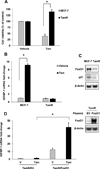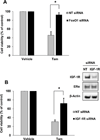IGF-1 Receptor Modulates FoxO1-Mediated Tamoxifen Response in Breast Cancer Cells
- PMID: 28096479
- PMCID: PMC5380564
- DOI: 10.1158/1541-7786.MCR-16-0176
IGF-1 Receptor Modulates FoxO1-Mediated Tamoxifen Response in Breast Cancer Cells
Abstract
Tamoxifen is a common adjuvant treatment for estrogen receptor (ER)α-positive patients with breast cancer; however, acquired resistance abrogates the efficacy of this therapeutic approach. We recently demonstrated that G protein-coupled estrogen receptor 1 (GPER1) mediates tamoxifen action in breast cancer cells by inducing insulin-like growth factor-binding protein-1 (IGFBP-1) to inhibit IGF-1-dependent signaling. To determine whether dysregulation of IGFBP-1 induction is associated with tamoxifen resistance, IGFBP-1 transcription was measured in tamoxifen-resistant MCF-7 cells (TamR) after tamoxifen (Tam) treatment. IGFBP-1 transcription was not stimulated in tamoxifen-treated TamR cells whereas decreased expression of FoxO1, a known modulator of IGFBP-1, was observed. Exogenous expression of FoxO1 rescued the ability of tamoxifen to induce IGFBP-1 transcription in TamR cells. As decreased IGF-1R expression is observed in tamoxifen-resistant cells, the requirement for IGF-1R expression on tamoxifen-stimulated IGFBP-1 transcription was investigated. In TamR and SK-BR-3 cells, both characterized by low IGF-1R levels, exogenous IGF-1R expression increased FoxO1 levels and IGFBP-1 expression, whereas IGF-1R knockdown in MCF-7 cells decreased tamoxifen-stimulated IGFBP-1 transcription. Interestingly, both 17β-estradiol (E2)-stimulated ERα phosphorylation and progesterone receptor (PR) expression were altered in TamR. PR is a transcription factor known to modulate FoxO1 transcription. In addition, IGF-1R knockdown decreased FoxO1 protein levels in MCF-7 cells. Furthermore, IGF-1R or FoxO1 knockdown inhibited the ability of tamoxifen to induce IGFBP-1 transcription and tamoxifen sensitivity in MCF-7 cells. These data provide a molecular mechanistic connection between IGF-1R expression and the FoxO1-mediated mechanism of tamoxifen action in breast cancer cells.Implications: Loss of IGF-1R expression is associated with decreased tamoxifen efficacy in patients with breast cancer and the development of tamoxifen resistance. This contribution identifies potential molecular mechanisms of altered tamoxifen sensitivity in breast cancer cells resulting from decreased IGF-1R expression. Mol Cancer Res; 15(4); 489-97. ©2017 AACR.
©2017 American Association for Cancer Research.
Conflict of interest statement
No potential conflicts of interest were disclosed.
Figures







References
-
- Jemal A, Siegel R, Ward E, Hao YP, Xu JQ, Thun MJ. Cancer Statistics, 2009. Ca-a Cancer Journal for Clinicians. 2009;59(4):225–249. - PubMed
-
- Clarke R, Leonessa F, Welch JN, Skaar TC. Cellular and molecular pharmacology of antiestrogen action and resistance. Pharmacological Reviews. 2001;53(1):25–71. - PubMed
-
- Ring A, Dowsett M. Mechanisms of tamoxifen resistance. Endocrine-Related Cancer. 2004;11(4):643–658. - PubMed
-
- Vivacqua A, Romeo E, De Marco P, De Francesco EM, Abonante S, Maggiolini M. GPER mediates the Egr-1 expression induced by 17 beta-estradiol and 4-hydroxitamoxifen in breast and endometrial cancer cells. Breast Cancer Research and Treatment. 2012;133(3):1025–1035. - PubMed
-
- Catalano S, Giordano C, Panza S, Chemi F, Bonofiglio D, Lanzino M, et al. Tamoxifen through GPER upregulates aromatase expression: a novel mechanism sustaining tamoxifen-resistant breast cancer cell growth. Breast Cancer Research and Treatment. 2014;146(2):273–285. - PubMed
MeSH terms
Substances
Grants and funding
LinkOut - more resources
Full Text Sources
Other Literature Sources
Medical
Research Materials
Miscellaneous

